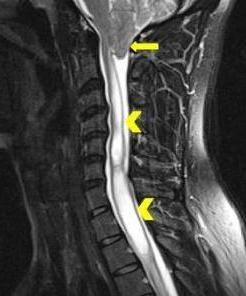Chiari I Malformation in a Young Man With Persistent Neck Pain
A 4-year history of headache and severe neck pain led to a diagnosis of Chiari I malformation in this patient. Here: symptoms, diagnostic tests, and treatment approaches.

A 29-year-old man presented with a 4-year history of headache and severe neck pain. The neck pain, which is constant, dull, and achy, radiates up to the posterior scalp and down both shoulders and is sometimes accompanied by occipital headaches. He noted that the headaches and neck pain increase in intensity with coughing, lifting, or exercising. On the visual analog scale, the patient reported a pain level of 6 on a scale of 0 to 10. He denied weakness, ataxia, radicular symptoms, and loss of bladder or bowel control. He stated that cough syrup helped relieve pain by decreasing his cough but acetaminophen, NSAIDs, and acetaminophen/oxycodone provided very limited pain relief. His pain did not improve with physical therapy and chiropractic manipulation.
On physical examination, the patient showed no sensory or reflex abnormality, had symmetric 5/5 strength in all extremities, and had a normal gait. On palpation, there was paraspinal and bony prominence tenderness. Spurling, Lhermitte, and root tension signs were negative. No abnormalities were seen on a flexion-extension radiograph of the cervical spine. A cervical MRI scan without contrast (Figure; T2-weighted image) revealed a Chiari I malformation with herniation of the cerebellar tonsils measuring up to 2.7 cm (arrow) and extensive syringomyelia (arrowheads).
The patient was referred to a neurosurgeon and underwent a posterior fossa decompression and C1-C2 laminectomy with duraplasty. The postoperative course was uneventful, and the patient reported some symptomatic relief. Several months later, however, the patient’s pain returned; the pain intensity was like that experienced before the surgery.
Discussion
Chiari I malformation is characterized by herniation of the cerebellar tonsils at least 5 mm below the foramen magnum. The true prevalence of Chiari I malformation is unknown, but it is considered to be 0.1% to 0.5% of the population.1 The exact cause of Chiari I malformation is also unknown; however, headaches and neck pain, the most common presentation, are believed to be caused by irritation of the meninges. The headaches and neck pain can be exacerbated with valsalva maneuvers, such as lifting and coughing.1-4 Although the symptoms of Chiari malformation can be broad, they may be similar to symptoms seen in patients with obstructive hydrocephalus or cerebellar deficits. The onset of symptoms of Chiari I malformation is usually insidious and generally occurs in the second to third decade of life.5 However, in one study, the average age of onset was 18 years.6
In 40% to 75% of cases, Chiari I malformation appears concurrently with syringomyelia.1,5,7-9 Syringomyelia is a defect in the spinal cord where a central cavitation forms, although it is unclear exactly how this happens. It is thought that the increased pressure of cerebrospinal fluid (CSF) causes pooling and extravasation of CSF into the cord structure.1,2
MRI is generally the preferred modality for diagnosing Chiari I malformation; high-resolution CT can be used in patients who cannot undergo MRI.1,10 The diagnosis is made when the cerebellar tonsils are 5 mm or more below the foramen magnum.
For symptomatic patients with Chiari I malformation, surgical decompression is the recommended treatment.1 The success rate for surgical treatment is 47% to 93%.11 About 12% of patients whose symptoms included headaches continued to have headaches after surgery. About 10% of patients who undergo surgery have some form of CSF disorder, and the rate of serious complications and mortality is less than 2%.12,13 Surgery is not recommended for asymptomatic patients who do not have syringomyelia. Instead, these patients can be managed with MRI and clinical monitoring. For asymptomatic patients with Chiari I malformation and concomitant syringomyelia, opinion varies on whether surgery is needed.
References
1. Speer MC, Enterline DS, Mehltretter L, et al. Chiari type I malformation with or without syringomyelia: prevalence and genetics. J Genet Couns. 2003;12:297.
2. Schijman E. History, anatomic forms, and pathogenesis of Chiari I malformations. Childs Nerv Syst. 2004;20:323-328.
3. Steinbok P. Clinical features of Chiari I malformations. Childs Nerv Syst. 2004;20:329-331.
4. Pascual J, Oterino A, Berciano J. Headache in type I Chiari malformation. Neurology. 1992;42:1519-1521.
5. Fernndez AA, Guerrero AI, Martnez MI, et al. Malformations of the craniocervical junction (Chiari type I and syringomyelia: classification, diagnosis and treatment). BMC Musculoskelet Disord. 2009;10(suppl 1):S1.
6. Nohria V, Oakes WJ. Chiari I malformation: a review of 43 patients. Pediatr Neurosurg. 1990-1991;16:222-227.
7. Menezes AH. Chiari I malformations and hydromyelia-complications. Pediatr Neurosurg. 1991-1992;17:146-154.
8. Wu YW, Chin CT, Chan KM, et al. Pediatric Chiari I malformations: do clinical and radiologic features correlate? Neurology. 1999;53:1271-1276.
9. Milhorat TH, Chou MW, Trinidad EM, et al. Chiari I malformation redefined: clinical and radiographic findings for 364 symptomatic patients. Neurosurgery. 1999;44:1005-1017.
10. Gundry CR, Heithoff KB. Imaging evaluation of patients with spinal deformity. Orthop Clin North Am. 1994;25:247-264.
11. McGirt MJ, Nimjee SM, Fuchs HE, George TM. Relationship of cine phase-contrast magnetic resonance imaging with outcome after decompression for Chiari I malformations. Neurosurgery. 2006;59:140-146.
12. Milhorat TH, Bolognese PA, Nishikawa M, et al. Association of Chiari malformation type I and tethered cord syndrome: preliminary results of sectioning filum terminale [published correction appears in Surg Neurol. 2009;72:556]. Surg Neurol. 2009;72:20-35.
13. Tubbs RS, McGirt MJ, Oakes WJ. Surgical experience in 130 pediatric patients with Chiari I malformations. J Neurosurg. 2003;99:291-296.